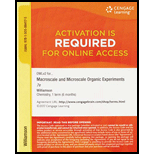
Interpretation:
The conclusion about the homogeneity of the distillate in the fractional distillation of ethanol-water mixture should be determined. Also, whether the mixture has a constant boiling point or not and is pure compound or not is to be determined.
Concept introduction:
The fractional distillation is a technique that is used to separate various components or fractions from a mixture on the basis of their volatilities. The fractional distillation can be used if the boiling point difference between the components is less than
A mixture with uniform composition and properties throughout is called homogenous mixture.
Want to see the full answer?
Check out a sample textbook solution
- 1. Which is more efficient for separating the components of a liquid mixture of a liquid mixture, simple or fractional distillation? Why? 2. Explain (in 1 – 3 sentences) how distillation works in separating simple mixtures.arrow_forwardWhy is fractional distillation more efficient than simple distillation when purifying liquid mixtures?arrow_forwardConcerning the following two mixtures, methanol/tetrahydrofuran and chloroform/ethylene glycol, could each mixture be separated using fractional distillation?arrow_forward
- A student obtained a solid product in laboratory synthesis. To verify the identity of the solid, she measured the milting point and found that the material melted over a 12°C range. After it had cooled, she measured the melting point of the same sample again and found that this time the solid HUD a sharp melting point at the temperature that is characteristic of the desired product Why were the two melting points different? What was responsible for the change in the melting point?arrow_forwardExplain and sketch the Born-Mayer equation to determine the crystallization energy of NaCl and MgCl2arrow_forwardCalculate the weight of benzene codistilled with each gram of water and the percentage composition of the vapor produced during a steam distillation. The boiling point of the mixture is 69.4°C. The vapor pressure of water at 69.4°C is 227.7 mm Hg. Compare the result with the data in the given table.arrow_forward
- Briefly explain the principles involved in the separation of the components of a mixture by solvent extraction.arrow_forwardphysical chemistry: With the given diagram below, How many phases does a mixture of these liquids have? Liquid Amount (mol) xT xW xE A 15 0.5 0.25 0.25 B 20 0.33 0.33 0.33 C 7.5 0.1 0.8 0.1 For the mixture in the problem above, what are the composition of the phases? If there are two phases, what are the compositions of the trichloromethane-rich and water-rich phases?arrow_forwardPAPER CROMATOGRAPHY • Define chromatography • Demonstrate an understanding of the process of chromatography • Describe the steps involved in a chromatography investigation Explanation Coloured inks are often made up of several different inks. Each colour of ink will get carried a different distance by the water, allowing you to see all of the different inks. Try this with different colours to see what actually goes into a colour. This technique is called chromatography and can be used in chemistry to find out what is in an unknown mixture. II. Materials .Felt tip pens (non-washable) . Kitchen roll .A bowl or cup . Water • Scissors III. Health and safety • Make sure that you thoroughly clean any equipment after the experiment before using for food IV. Procedure Method 1 1. Take a sheet of kitchen roll and draw a simple picture with a non-washable felt tip pen. 2. Place the sheet over an empty bowl. This is to keep the paper from getting too wet. 3. Carefully add a few drops of water…arrow_forward
- 1.Define binary mixture 2. Define density 3. Give an abstract of determination of excess molar volume of binary mixtures of water and methanol by measuring densityarrow_forward3. The phase diagram for the simple system aluminum copper is drawnbelow. Answer the following questions by referring to this diagram.A. How many phases will be present if an aluminum-copper mixture containing 80% copper is heated to 1000oC?B. If the system described in (A) is slowly cooled, at what temperature willa solid start to appear? What is this solid?C. What phases will be present if the mixture (A) is further cooled down to600oC?D. What is the concentration of the saturated solution of copper inaluminum at 800oC?E. For a mixture given in (A), at what temperature will the eutectic mixturecrystallize out?F. What is the percentage by weight of copper in the eutectic mixture formed in (E)?arrow_forward7.5. For this chemical equilibrium in an enclosed system, how many degrees of freedom are there?arrow_forward
 Macroscale and Microscale Organic ExperimentsChemistryISBN:9781305577190Author:Kenneth L. Williamson, Katherine M. MastersPublisher:Brooks Cole
Macroscale and Microscale Organic ExperimentsChemistryISBN:9781305577190Author:Kenneth L. Williamson, Katherine M. MastersPublisher:Brooks Cole EBK A SMALL SCALE APPROACH TO ORGANIC LChemistryISBN:9781305446021Author:LampmanPublisher:CENGAGE LEARNING - CONSIGNMENT
EBK A SMALL SCALE APPROACH TO ORGANIC LChemistryISBN:9781305446021Author:LampmanPublisher:CENGAGE LEARNING - CONSIGNMENT Physical ChemistryChemistryISBN:9781133958437Author:Ball, David W. (david Warren), BAER, TomasPublisher:Wadsworth Cengage Learning,
Physical ChemistryChemistryISBN:9781133958437Author:Ball, David W. (david Warren), BAER, TomasPublisher:Wadsworth Cengage Learning,


